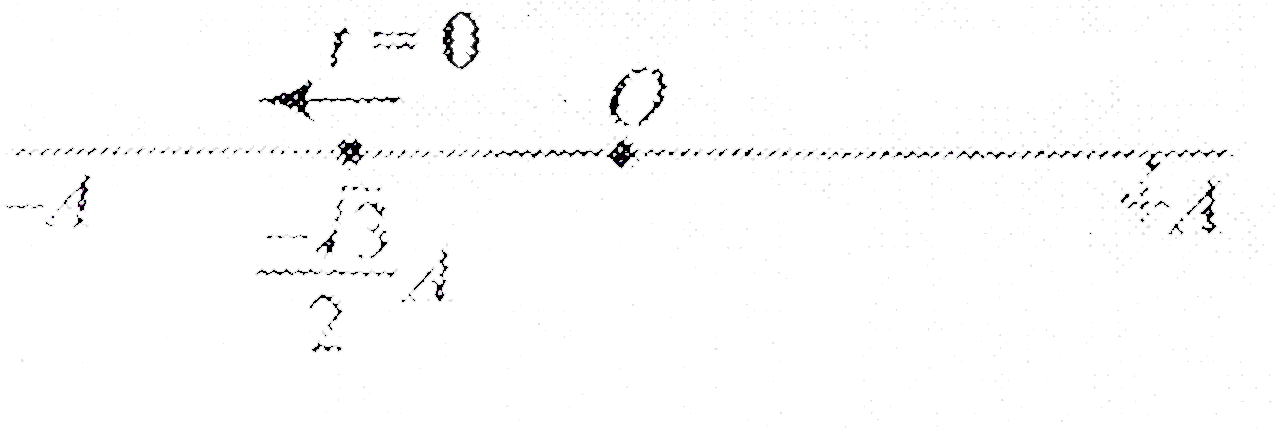A particle starts from point x=−√32A and move towards negative extreme as shown,
_S01_011_Q01.png)
(a) Find the equation of the SHM
(b) Find the time taken by the particle to go directly from its initial position to negative extreme.
(c) Find the time taken by the particle to reach at mean position.
_S01_011_S01.png)
(a) Figure shows the solution of the problem with the help of phasor. Horizontal component of velocity at Q gives the required direction.
of velocity at t=0 so we will choose it.
In ΔOSQ:cosθ=√3/2AA=√32⇒θ=π6
Now ϕ=3π2−π6=8π6=4π3
So equation of SHM is x=Asin(ωt+4π3)
(b) Now to reach the particle at left extreme point it will travel angle θ along the circle. So time taken,
t=πω=π6ω⇒t=T12sec
(c) To reach the particle at mean position at mea n position it will travel angle α=π2+π6=2π3
So, time taken =αω=T3sec.
Topper's Solved these Questions
- BOOK - ALLENCHAPTER - SIMPLE HARMONIC MOTIONEXERCISE - Exercise-01117videos
SIMPLE HARMONIC MOTION
- BOOK - ALLENCHAPTER - SIMPLE HARMONIC MOTIONEXERCISE - Exercise-0219videos
SIMPLE HARMONIC MOTION
- BOOK - ALLENCHAPTER - RACEEXERCISE - Basic Maths (Wave Motion & Dopplers Effect) (Stationary waves & doppler effect, beats)25videos
RACE
- BOOK - ALLENCHAPTER - TEST PAPEREXERCISE - PHYSICS4videos
TEST PAPER
Similar Questions
A particle starts from A/2 and moves towards positive extreme as shown below. Find the equation of the SHM. Given amplitude of SHM is A.
 View Solution
View SolutionA particle starts from mean position and moves towards positive extreme as show below. Find the equation of the SHM, Amplitude of SHM is A.
_S01_003_Q01.png) View Solution
View Solution
Knowledge Check
- Question 1 - Select One or More
A particles starts from point x=−√32A and move towards negative extrene as shown . If the time period of oscillation is T , them
 AThe equation of the SHM is x=Asin(2πT+4π3)BThe time taken by the particle tto go directly from its initial position to negative extreme is T12CThe time taken by the particle to reach at mean position is T3DThe equation of the SHM is x=Asin(2πT+π3)
AThe equation of the SHM is x=Asin(2πT+4π3)BThe time taken by the particle tto go directly from its initial position to negative extreme is T12CThe time taken by the particle to reach at mean position is T3DThe equation of the SHM is x=Asin(2πT+π3) - Question 2 - Select One
A particle executes S.H.M with time period 12 s. The time taken by the particle to go directly from its mean position to half its amplitude.
A4 sB3 sC6 sD1 s - Question 3 - Select One
A particle executes SHM with a time period of 4 s . Find the time taken by the particle to go from its mean position to half of its amplitude . Assume motion of particle to start from mean position.
A1/3 sB2/3 sC4/3 sD5/3 s
A particle start form mean position and moves towards positive extreme as shown. Find the equation of the SHM. Amplitude of SHM is A.
 View Solution
View SolutionA particle executes a simple harmonic motion of time period T. Find the time taken by the particle to go directly from its mean position to half the amplitude.
View SolutionA particle executes SHM with a time period of 4s. Find the time taken by the particle to go directly from its mean position to half of its amplitude.
View SolutionA particle executes SHM with a time period of 12s. Find the time taken by the particle to go directly from its mean position to half of its amplitude.
View SolutionA particle of mass 2 kg executing SHM has amplitude 10 cm and time period 1s. Find (a) the angular frequency (b) the maximum speed (c ) the maxmum acceleration (d) the maximum restoring force ( e) the speed when the displacement from the mean position is 8 cm (f) the speed after 112s the particle was at the extreme position (g) the time taken by the particle to go directly from its mean position to half the amplitude (h) the time taken by the particle to go directly from its extreme position to half the amplitude.
View Solution

